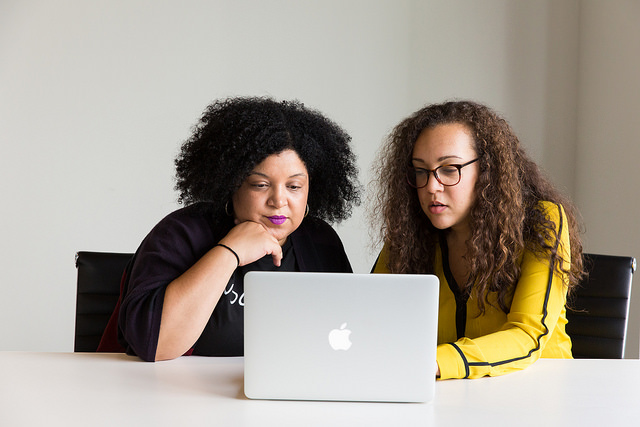To truly change the world, entrepreneurship has to include everyone. Technology pioneer Freada Kapor Klein recently told me: “We can’t close gaps to access and opportunity without having our entrepreneurs come from the communities we are trying to serve. Lived experience is essential in creating successful businesses.”
Unfortunately, today, we’re leaving nearly half the entrepreneurs in the world off the playing field. Between 2011-2013, women led just three percent of US venture-backed companies, according to a Babson College study.
To gain a better understanding of the problem, and hopefully identify some possible solutions, we at Village Capital have been paying particular attention to the distinct resource gap that women entrepreneurs face. For the past five years, we have partnered with Goizueta Business School at Emory University to track the performance of more than 500 graduates of our entrepreneur programs, and monitor the 55 investments we have made through our affiliated fund over time. To get appropriate and comparative data, we also began measuring the performance of all the startups that apply to our programs—nearly 1,000 per year around the world. (Village Capital runs venture development program worldwide for entrepreneurs solving major global problems. Its affiliated venture fund, VilCap Investments, invests in program graduates through a unique peer selection model in which the entrepreneurs themselves choose who receives investment capital.)
Our initial data suggest a serious gap for women founders. When companies first contact us, those with a female co-founder are generally performing better than their peers—and they are seriously under-funded. Controlling for similar industries and geographies, female-run companies outperform male-led firms by at least 20 percent in revenue earned and full- and part-time jobs created, yet still attract only 83 percent of the outside equity investment, 84 percent of the philanthropic donations, and 63 percent of the debt financing as all-male teams.
Now, the good news: In our experience, it doesn’t take much investment in women entrepreneurs to close the gap. In fact, betting on women entrepreneurs with a first-time seed investment nearly closes the achievement gap between female and male founders. “Early intervention” seems to be the key.
We have measured performance over time in the companies with women co-founders who received a seed investment from Village Capital. Controlling for confounding variables, female-led portfolio companies have raised only 2 percent less outside funding as their all-male counterparts, while generating 6 percent more revenue and earning 26 percent more in profits.
In short, making the first investment in a company started by an under-represented founder has made all the difference in closing the opportunity gap. And it’s good business sense: the investments are outperforming.
In-Group Bias
If evidence suggests that making initial investments in women closes the achievement gap—and these companies are delivering better financial performance—why aren’t more firms investing in women?
“In-group bias,” a well-documented phenomenon in social science that describes a person’s natural proclivity to favor others with shared backgrounds or experiences, might be the problem. According to a 2014 Babson study, venture capital firms with female partners are three times as likely to invest in companies with women CEOs. But just six percent of partners at venture firms are women. Venture capitalists are overwhelmingly male, and invest mostly in companies with male leader.
Here’s how that male-dominated structure can foster unintentional and implicit biases. In a recent article, venture capitalist Lindsay Meyer described how investors’ networking events such as “poker nights and skeet-shooting outings” can be unintentionally “male-focused” and restrictive toward females. Nearly every angel investor asks for a “warm introduction,” limiting the dataset of companies that can raise funding to those socially connected to venture firms, and even when companies get the chance to pitch investors, they risk in-group bias. As Y-Combinator founder Paul Graham once said, “I can be tricked by anyone who looks like Mark Zuckerberg.”
Venture firms have cited that change is difficult, however. Even Ben Horowitz struggles to find female partners for his $4 billion venture firm, Andreessen Horowitz. Andreessen says he has tried to hire a woman general partner five times, but has been turned down each time. The competition is simply too fierce from Fortune 500 companies for high-quality female partners, Horowitz says.
Yet as an investor, if you aren’t changing the group who is making decisions, the same results will persist.
System Change
Changing the deciders is one way to deliver better results. Changing the investment process may be another. A new wave of innovators are developing alternative means for access to capital—for example, 42 percent of Indiegogo’s successful crowdfunding campaigns are run by women.
While our experience is not comprehensive, we at Village Capital have seen similarly promising results through a peer-selection approach over the past five years. We find and build groups of entrepreneurs working in similar sectors (for example, the top 12 entrepreneurs in agriculture technology in the United States), and we pre-commit investment capital to the entrepreneurs that are highest-rated by their peers. Ranking is transparent (all votes are public, and entrepreneurs must defend their ranking to their peers) and group-focused (you can’t rank yourself).
What results are we seeing? Twenty five percent of the entrepreneurs eligible for investment have had women co-founders, yet women have received investment nearly 40 percent of the time. Our women founders cite that the process of peer selection is fundamentally open and collaborative, rewarding founders who work well with each other.
With respect to gender, does peer selection have in-group bias? We looked at the voting process over the past five years, and the answer seems to be no. Women were not more statistically likely to rank women more highly; and men were not statistically more likely to rank men highly. Why is it this way? Maybe peers are more open to one others’ ideas; maybe a more diverse group is less likely to exhibit in-group bias; and maybe transparent (vs. secret) rankings create a more level playing field.
More To Do
The results we’ve seen are promising, but admittedly come from a limited dataset. This initial data point thus shows evidence of promise for future study and experimentation. We encourage further study on both the results on investing in under-represented founders, including women and people of color, and the impact of decision-makers and decision-making processes on portfolio results.
We still have a long way to go towards making entrepreneurship truly inclusive, but by making some simple changes to the process, we’re seeing a step forward in results—and a more level playing field for all.
[seperator style=”style1″]Disclosure[/seperator]
This article originally appeared in the Stanford Social Innovation Review (Oct 28, 2015). Reposted with permission.











